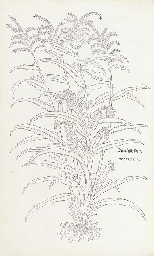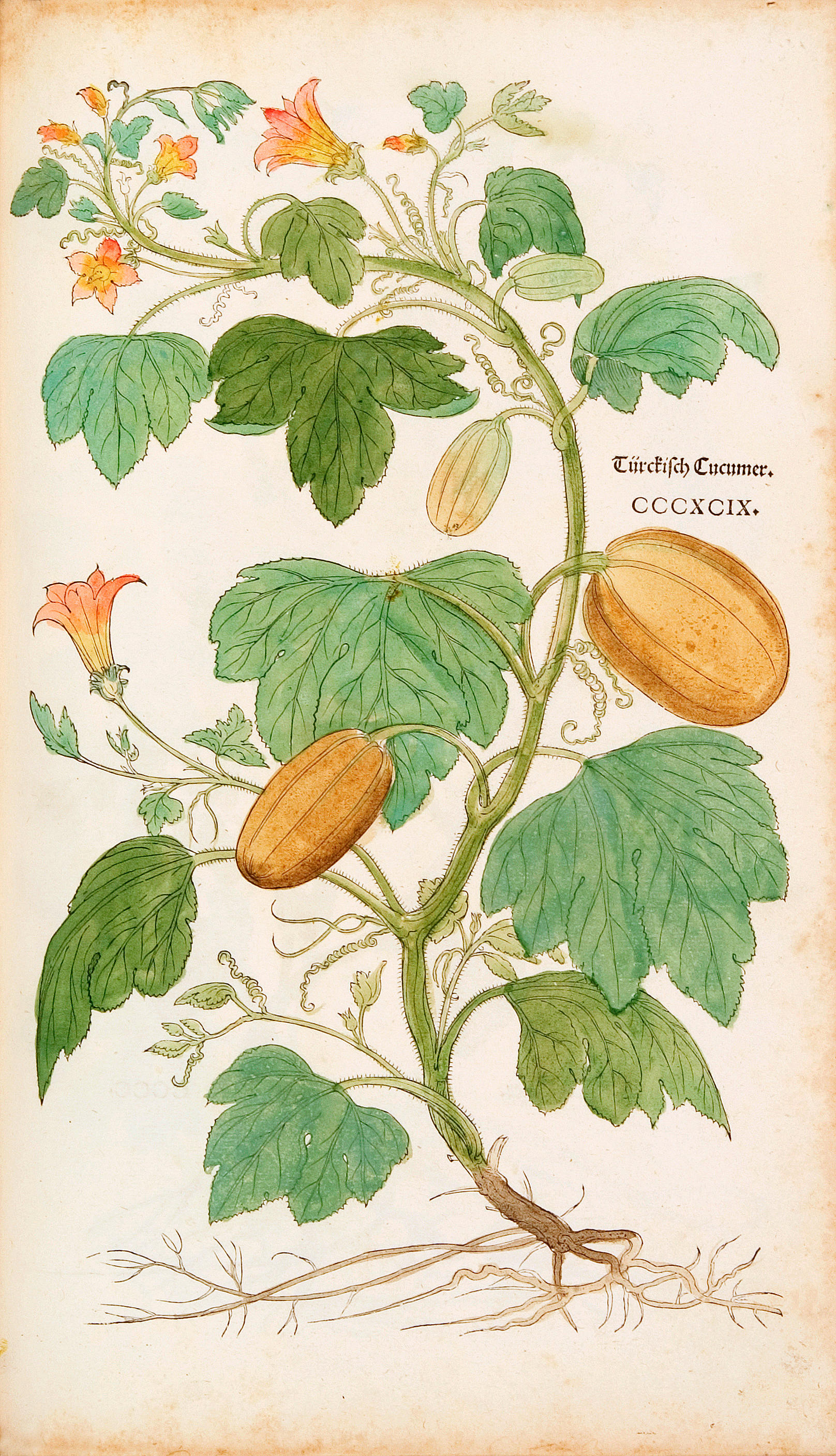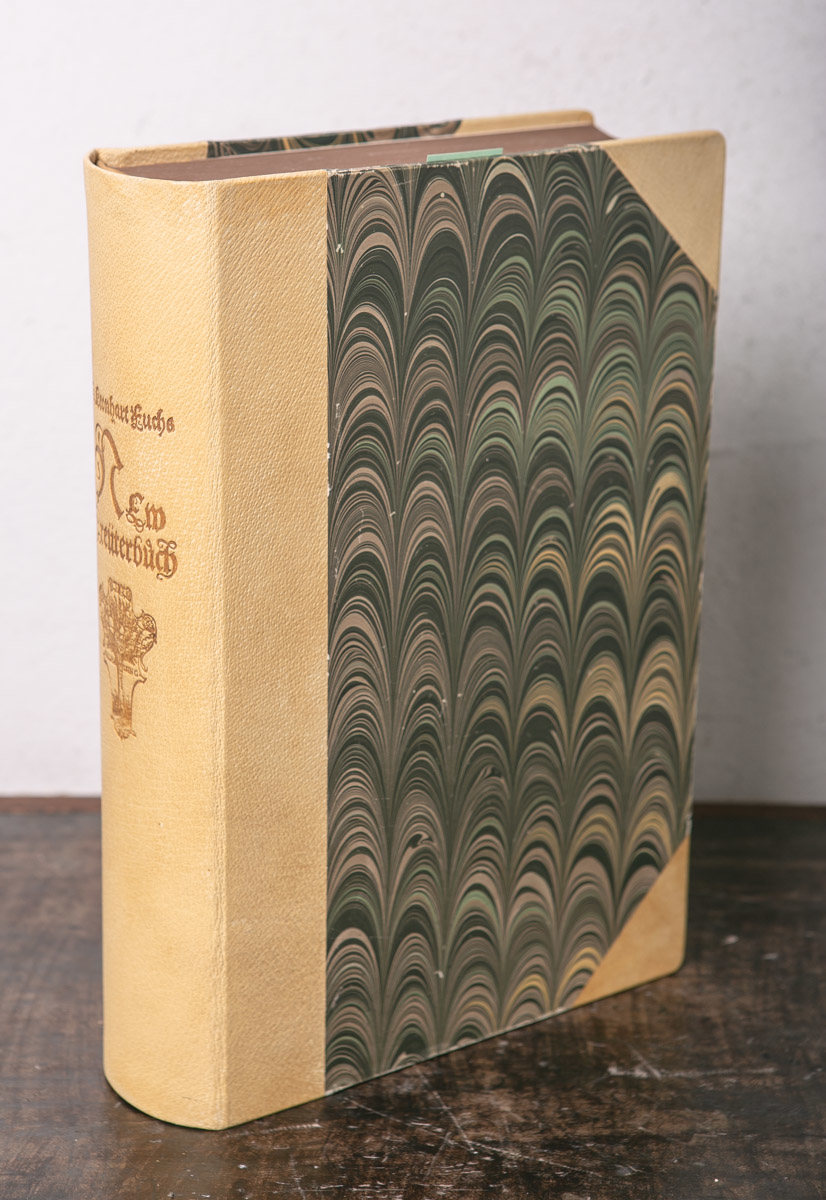FUCHS, Leonhard (1501-1566). New Kreüterbuch . Basel: Michael Isingrin, 1543.
FUCHS, Leonhard (1501-1566). New Kreüterbuch . Basel: Michael Isingrin, 1543. 2° (365 x 237 mm). Woodcut printer's device on title and on final recto, full-page woodcut portrait of Fuchs on title verso, 517 botanical woodcuts (15 with old hand-coloring) by Viet Rudolph Speckle after Heinrich Füllmaurer and Albert Meyer, woodcut portraits of the three artists at end, woodcut historiated initials in several sizes. (Some mostly marginal staining, Ff2-Gg4 with small defect touching one woodcut, a few short marginal tears.) Contemporary blind stamped pigskin over wooden boards, brass catch plates (clasps missing, some light staining and wear.) Provenance : Joseph von Gullingstein (inscription: “Das dieses Kräuterbuch nach einem sehr spaten Hinsterben meinem Herzgelieb-ten Schwagern Joseph Von Gullingstein als ein Erbseigenthum zugehöre, Bezeige ich mit meiner unterzogenen Handschrift Act. Gotteszell den 27. April 1793 Regina v. und zu Gulling-Stein. HofRäthin und HofRichterin hiroben” on front pastedown); “Ex libris Nobilis Francisci Fidelis Leiderer Medicinae Candidati Constat 54;” Bibljoteka Julinska (bookplate); The Warren H. Corning Collection Horticultural Classics (bookplate). FIRST EDITION IN GERMAN OF “PERHAPS THE MOST CELEBRATED AND MOST BEAUTIFUL HERBAL EVER PUBLISHED” ( PMM ), with amendments and an additional 5 woodcuts not present in the Latin edition of the previous year. As Fuchs explains in the preface to this German edition, he wished to reach an audience broader than the Latinate scholar or physician for whom herbals had been a necessary medical tool throughout Antiquity and the Middle Ages. Fuchs realized that his own herbal could provide that knowledge not only to the specialist but also to the layman interested in plants and the popular remedies derived from them, or simply interested in the natural world surrounding him. In preparing the German edition Fuchs took the opportunity to augment his text with an index of illnesses treatable with herbs, enhancing its usefulness and popular appeal. Fuchs was an ardent Galenist, and makes ample reference to his work. In contrast to many of the crude herbals which preceded it, Fuchs's botanical descriptions are very accurate and mark a significant advance in medical botany. His detailed plant-portraits were highly influential: they were reused in all later editions, copied in the works of Bock, Dodoens, William Turner and others, and pirated in contemporary botanical works -- a practice which Fuchs fought vigorously. The illustrations depict over 400 German and 100 foreign plants, including the first description of several recently-discovered American plants, such as maize (mistakenly thought by Fuchs to originate in Turkey), pumpkin, chili pepper, and snap bean. The drawings were made from life by Albert Meyer, largely based on plants in Fuchs's garden at Tübingen, then transferred to the woodblock by Heinrich Füllmaurer and cut into wood by Viet Rudolph Speckle. Portraits of the three artists are included in the work -- one of the earliest such honors accorded to contributing artists. The woodcuts are those used in the 1542 edition, plus an additional five, depicting "Hunerbis," "Spitziger Wegerich," "klein Schlangen kraut," "Knabenkrautweible, das mittel," and "Kuchens chell." Adams F-1107; Cleveland Collections 62 (GC copy this copy); Nissen BBI 659; Pritzel 3139; Stafleu & Cowan TL2 1910.
FUCHS, Leonhard (1501-1566). New Kreüterbuch . Basel: Michael Isingrin, 1543.
FUCHS, Leonhard (1501-1566). New Kreüterbuch . Basel: Michael Isingrin, 1543. 2° (365 x 237 mm). Woodcut printer's device on title and on final recto, full-page woodcut portrait of Fuchs on title verso, 517 botanical woodcuts (15 with old hand-coloring) by Viet Rudolph Speckle after Heinrich Füllmaurer and Albert Meyer, woodcut portraits of the three artists at end, woodcut historiated initials in several sizes. (Some mostly marginal staining, Ff2-Gg4 with small defect touching one woodcut, a few short marginal tears.) Contemporary blind stamped pigskin over wooden boards, brass catch plates (clasps missing, some light staining and wear.) Provenance : Joseph von Gullingstein (inscription: “Das dieses Kräuterbuch nach einem sehr spaten Hinsterben meinem Herzgelieb-ten Schwagern Joseph Von Gullingstein als ein Erbseigenthum zugehöre, Bezeige ich mit meiner unterzogenen Handschrift Act. Gotteszell den 27. April 1793 Regina v. und zu Gulling-Stein. HofRäthin und HofRichterin hiroben” on front pastedown); “Ex libris Nobilis Francisci Fidelis Leiderer Medicinae Candidati Constat 54;” Bibljoteka Julinska (bookplate); The Warren H. Corning Collection Horticultural Classics (bookplate). FIRST EDITION IN GERMAN OF “PERHAPS THE MOST CELEBRATED AND MOST BEAUTIFUL HERBAL EVER PUBLISHED” ( PMM ), with amendments and an additional 5 woodcuts not present in the Latin edition of the previous year. As Fuchs explains in the preface to this German edition, he wished to reach an audience broader than the Latinate scholar or physician for whom herbals had been a necessary medical tool throughout Antiquity and the Middle Ages. Fuchs realized that his own herbal could provide that knowledge not only to the specialist but also to the layman interested in plants and the popular remedies derived from them, or simply interested in the natural world surrounding him. In preparing the German edition Fuchs took the opportunity to augment his text with an index of illnesses treatable with herbs, enhancing its usefulness and popular appeal. Fuchs was an ardent Galenist, and makes ample reference to his work. In contrast to many of the crude herbals which preceded it, Fuchs's botanical descriptions are very accurate and mark a significant advance in medical botany. His detailed plant-portraits were highly influential: they were reused in all later editions, copied in the works of Bock, Dodoens, William Turner and others, and pirated in contemporary botanical works -- a practice which Fuchs fought vigorously. The illustrations depict over 400 German and 100 foreign plants, including the first description of several recently-discovered American plants, such as maize (mistakenly thought by Fuchs to originate in Turkey), pumpkin, chili pepper, and snap bean. The drawings were made from life by Albert Meyer, largely based on plants in Fuchs's garden at Tübingen, then transferred to the woodblock by Heinrich Füllmaurer and cut into wood by Viet Rudolph Speckle. Portraits of the three artists are included in the work -- one of the earliest such honors accorded to contributing artists. The woodcuts are those used in the 1542 edition, plus an additional five, depicting "Hunerbis," "Spitziger Wegerich," "klein Schlangen kraut," "Knabenkrautweible, das mittel," and "Kuchens chell." Adams F-1107; Cleveland Collections 62 (GC copy this copy); Nissen BBI 659; Pritzel 3139; Stafleu & Cowan TL2 1910.






.jpg)





Testen Sie LotSearch und seine Premium-Features 7 Tage - ohne Kosten!
Lassen Sie sich automatisch über neue Objekte in kommenden Auktionen benachrichtigen.
Suchauftrag anlegen